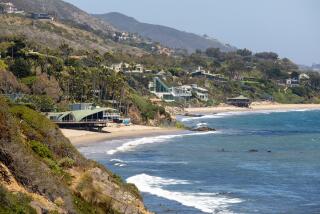Recession Lowers Prices of Luxury Homes, Slows Sales : Economy: The drag on a market that thrived in bad times shows this downturn may be worse than others.
In Orange, the asking price for a 30,000-square-foot mansion owned by the founder of the Clothestime womenâs apparel chain has been cut by nearly one-third to $14.95 million, but the home still has not attracted a buyer after nearly a year.
In Montecito near Santa Barbara, a Mediterranean-style villa owned by musician Kenny Loggins has languished on the market for more than six months, despite a $2-million price reduction.
In Bel-Air, a 6,500-square-foot home sold last month for about $1.5 million in a neighborhood where similar homes had brought $3 million just 18 months ago.
For years, the luxury home market defied economic gyrations and kept expanding through good times and bad. But now, even the wealthy are beginning to feel the chill of recession, as home prices tumble and houses go unsold for longer periods than at any time in the last 10 years.
The turn of fortunes at the upper end of the housing market is a sign that the current economic downturn--fueled by fading consumer confidence and uncertainty over the Persian Gulf War--may be cutting a wider swath than previous slumps. And a worldwide economic slowdown is adding to the woes of the luxury home market here, as wealthy foreign investors lose interest in acquiring a piece of once-coveted prime U.S. real estate.
Some observers see a fundamental change in the top stratum of the real estate market: The wealthy, who for years viewed expensive homes as a rapidly appreciating investment, are now more hard-nosed. If they cannot find a home they intend to keep, they are staying out of the luxury home market altogether, real estate agents report.
The federal government does not break out statistics on luxury home sales, but real estate agents and industry experts estimate that, nationwide, between 11,000 and 13,000 homes priced at $1 million or more were sold in 1990. That was the first drop, they say, in more than a decade and compares to roughly 16,000 such homes sold in 1989.
According to one Orange County real estate broker, sales of $1 million-plus homes averaged about 11 units per month in the last four months of 1990, down from 22.5 per month sold in the first eight months of the year.
âPrices and unit sales are way down--as much as 35%,â said Stuart N. Siegel, executive vice president of New York-based Sotheby International Realty, a leading luxury home broker. Siegel said that in the 1980s, wealthy sellers often set a new price benchmark each time they sold their homes. Now, he said, sellersâ only concern is âsimply of disposing of property.â
As in the overall housing market, demand for expensive homes varies from region to region--with Texas and the Midwest faring better than most. For example, John A. Daugherty Jr., president of a Houston-based real estate firm that specializes in selling luxury homes, says his company sold $305-million worth of property in 1990, a 14% increase over the previous year.
But demand is soft in the South, the Northeast and the once booming Pacific Northwest, as well as in California, which alone accounts for about one-third to one-half of U.S. luxury home sales, according to interviews with brokers and real estate experts across the country.
Jeffery Lee, chief operating officer for Harlan Lee & Associates, a luxury home builder in Marina del Rey, said that since Jan. 1, 1990, his company has sold only eight homes in a 57-home development in Calabasas where houses are priced from $800,000 to $1.26 million. Lee said he sold 14 homes in the last 10 months of 1989, when the development first opened.
Before last year, sales in a suburban Washington, D.C., development called Avenel had been going like gangbusters. But after selling an average of more than 100 a year since 1987, only 41 of the homes--priced from $600,000 to $1.6 million--were sold in 1990.
âThe luxury market is certainly a lot softer now than the lower range,â said Anthony Natelli, general partner for the projectâs developer, Potomac Investment Associates of Gaithersburg, Md.
Harley E. Rouda, president of the National Assn. of Realtors, believes that the downturn is temporary. He said wealthy people have more secure employment as well as higher incomes than other Americans. âDemand for luxury homes (will be) steady through the 1990s,â he predicted. But other experts think the luxury home market is going through a basic change and that a recovery may be a way off.
âThe high end of the market has dropped off much more profoundly than any other part of the market,â said John Karevoll, who publishes the La Jolla-based real estate investment report âDataquick.â âPeople who buy million-dollar homes donât have the same agenda as other home buyers anymore. They have become real cautious.â
That assessment is a sharp departure from the mentality of the 1980s, when the wealthy, buoyed by a booming stock market and nearly eight straight years of economic expansion, flooded into the luxury home market and bid up prices.
The highest price ever paid in the United States for a single-family home was set last May, just before the current slump began. Music executive David Geffen paid $47.5 million for movie mogul Jack L. Warnerâs nine-acre Beverly Hills estate.
But experts say the luxury home frenzy probably reached its peak in 1986, when Hollywood director Aaron Spelling paid $10.5 million for singer Bing Crosbyâs house near West Los Angeles and promptly leveled most of it, spending millions to build a huge new edifice whose more than 60,000 square feet rival a typical department store.
Those heady days of spending were fueled by an explosion of American millionaires. Their numbers nearly doubled to about 1 million during the 1980s. Also, foreign buyers from the Middle East, Latin America and Japan flooded the U.S. luxury home market.
But last summerâs stock market and real estate slump took a lot of muscle out of many financial portfolios. Congress also imposed a new obstacle to luxury spending last year with consumption taxes on expensive jewelry, furs, yachts and automobiles. Federal law also bars deductions for mortgage interest on loans of more than $1 million on a taxpayerâs primary residence.
In addition, experts say builders miscalculated demand and erected too many high-priced homes at a time when even many wealthy buyers had reached a point where they could not afford to move up in the market.
Brokers say that, no matter what the economic conditions, it often takes a long time to sell luxury homes because of the smaller number of qualified buyers. But even the most upbeat real estate agents say they are amazed at how soft the market has become.
And they are working harder than ever to make a sale.
To spur interest in Logginsâ Montecito estate, called Santa Lucia, Prudential California Realty has sent an 8 1/2-minute videotape to five prospective buyers. It has distributed more than 2,500 brochures and arranged tours for 20 people in hopes that one of them will pay $12 million for the 20-acre villa.
But agent Penelope Williams is discouraged. âThere isnât the great demand . . . to rush out and buy a house in this price range. Itâs a sign of the times.â
A similar frustration faces real estate agents in Orange County, where a 15,000-square-foot home that was part of the Ahmanson estate on Harbor Island in Newport Beach has remained on the market for 13 months, even though the price has been reduced sharply and now is less than $15 million.
And the home of Clothestime founder Michael P. DeAngelo has remained unsold after almost a year, despite amenities such as 12 bathrooms, two pools, a gymnasium and servantsâ suites.
The soft market is even starting to worry luxury home owners who do not have their homes up for sale.
For example, Earl W. Fisher, president of Fisher Edwards Investment Counsel in Los Angeles, said his phone used to ring at least once a month with callers offering to pay up to $4 million for his historic four-bedroom adobe home, which overlooks the Pacific Ocean in Santa Monica.
But in the past year, he said: âI have not had any offers. The real estate bubble has certainly burst.â
More to Read
Inside the business of entertainment
The Wide Shot brings you news, analysis and insights on everything from streaming wars to production â and what it all means for the future.
You may occasionally receive promotional content from the Los Angeles Times.










